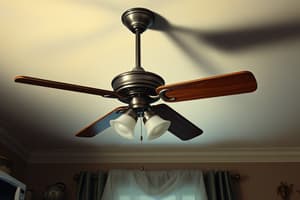Podcast
Questions and Answers
What type of lighting is designed to enhance visual clarity for specific tasks like reading or working on a computer?
What type of lighting is designed to enhance visual clarity for specific tasks like reading or working on a computer?
- Natural Lighting
- Accent Lighting
- Ambient Lighting
- Task Lighting (correct)
Which type of lighting is used to draw attention to specific features or objects within a space?
Which type of lighting is used to draw attention to specific features or objects within a space?
- Ambient Lighting
- Accent Lighting (correct)
- Natural Lighting
- Task Lighting
In the early stages of human history, what sources were used for lighting before the development of artificial lights?
In the early stages of human history, what sources were used for lighting before the development of artificial lights?
- Electric bulbs
- Natural light and fire (correct)
- Gas lighting
- Oil lamps
What kind of lighting provides a consistent level of visibility throughout an area and is often delivered by ceiling fixtures?
What kind of lighting provides a consistent level of visibility throughout an area and is often delivered by ceiling fixtures?
What modern technologies are mentioned in the text as advancements in lighting?
What modern technologies are mentioned in the text as advancements in lighting?
How does exposure to sunlight during the day affect circadian rhythms?
How does exposure to sunlight during the day affect circadian rhythms?
What effect does blue light exposure have on individuals?
What effect does blue light exposure have on individuals?
How do LED bulbs contribute to energy efficiency?
How do LED bulbs contribute to energy efficiency?
What is an important factor to consider when designing a lighting system?
What is an important factor to consider when designing a lighting system?
Why is understanding and controlling lighting essential according to the text?
Why is understanding and controlling lighting essential according to the text?
Flashcards are hidden until you start studying
Study Notes
Lighting: Bringing Illumination into Our World
Lighting is often overlooked, yet it plays a crucial role in our daily lives. It sets the mood in our homes and workplaces, helps us navigate public spaces safely, and even influences our health and wellbeing. In this article, we'll explore some of the most important aspects of lighting.
A Brief History of Lighting
Early humans used natural light from the sun and fire to illuminate their surroundings. As time progressed, society developed technologies such as oil lamps, gas lighting, and electric bulbs. Today, there are various types of artificial lights that serve different purposes and can be controlled using switches, sensors, or timers.
Types of Lighting
Ambient Lighting
Ambient lighting refers to the general illumination that provides a consistent level of visibility throughout an area. This type of lighting is typically provided by ceiling fixtures like recessed cans, track lights, or chandeliers.
Task Lighting
Task lighting is designed to enhance visual clarity for specific tasks, such as reading, sewing, or working on a computer. Examples include desk lamps, floor lamps, and under-cabinet lighting.
Accent Lighting
Accent lighting is used to draw attention to particular features or objects within a space. These may include wall sconces, picture lights, or decorative floor lamps with uplit shades.
Effects of Lighting on Human Health and Behavior
Circadian Rhythms
Human bodies have internal clocks called circadian rhythms, which regulate sleep patterns, hormone release, appetite, and other important activities. Exposure to sunlight during the day helps reset these rhythms so that you wake up feeling refreshed and go to sleep when it gets dark. Artificial lighting can disrupt this cycle if it's too bright or too dim at night.
Mood and Emotions
The right amount of light can improve your mood and productivity. For example, blue light exposure has been linked with improving alertness, raising core body temperature, boosting reaction times, and helping people feel more awake. On the other hand, too much darkness or insufficient lighting can contribute to feelings of depression or sadness.
Energy Efficiency and Sustainability
Today's LED technology offers significant energy savings compared to traditional incandescent or fluorescent bulbs. By converting electrical power into light, they generate very little heat, last longer, and consume less energy. However, there's always room for improvement, particularly regarding recycling old LED bulbs and reducing the environmental impact of manufacturing new ones.
Design Considerations
When designing a lighting system, consider factors such as amount of light needed, color rendering index (CRI) to ensure accurate color representation, and the desired atmosphere or effect. Reflective surfaces, such as mirrors or shiny finishes, enhance ambient lighting while absorptive materials like carpets or curtains diffuse task lighting.
In conclusion, understanding and controlling lighting is essential for creating comfortable living spaces, ensuring safety and security, and promoting health and wellbeing. From the development of early devices to modern energy-efficient solutions, lighting continues to evolve, playing a key role in our daily lives.
Studying That Suits You
Use AI to generate personalized quizzes and flashcards to suit your learning preferences.




